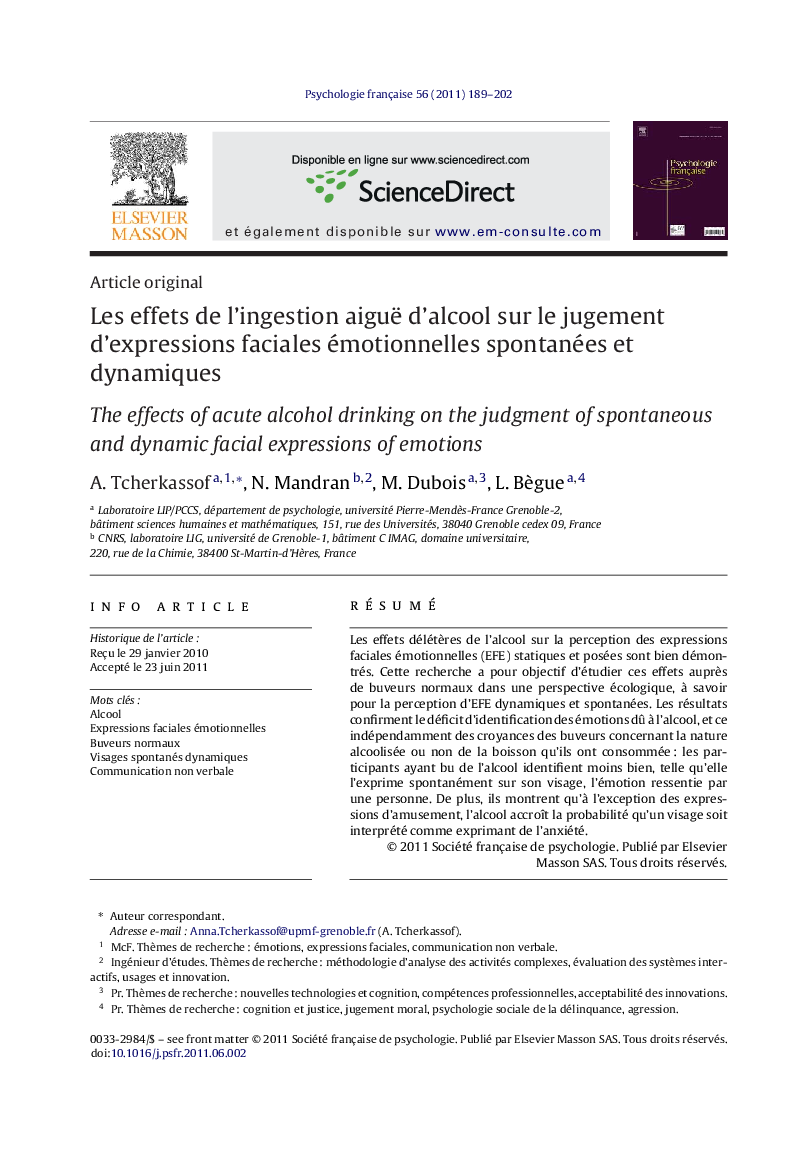| کد مقاله | کد نشریه | سال انتشار | مقاله انگلیسی | نسخه تمام متن |
|---|---|---|---|---|
| 336887 | 547349 | 2011 | 14 صفحه PDF | دانلود رایگان |

RésuméLes effets délétères de l’alcool sur la perception des expressions faciales émotionnelles (EFE) statiques et posées sont bien démontrés. Cette recherche a pour objectif d’étudier ces effets auprès de buveurs normaux dans une perspective écologique, à savoir pour la perception d’EFE dynamiques et spontanées. Les résultats confirment le déficit d’identification des émotions dû à l’alcool, et ce indépendamment des croyances des buveurs concernant la nature alcoolisée ou non de la boisson qu’ils ont consommée : les participants ayant bu de l’alcool identifient moins bien, telle qu’elle l’exprime spontanément sur son visage, l’émotion ressentie par une personne. De plus, ils montrent qu’à l’exception des expressions d’amusement, l’alcool accroît la probabilité qu’un visage soit interprété comme exprimant de l’anxiété.
This study is interested in the link between acute alcohol consumption and the perception of dynamic and spontaneous emotional facial expressions (EFE). The noxious effects of alcohol on EFE recognition are now well demonstrated (Attwood et al., 2009a). Studies showed that alcohol drinking impairs the judgment of facial expressions, especially of negative ones (EFE of anger and disgust notably). However, such effects have been observed for the judgment of artificial material (static/posed/morphed/EFE). Yet, everyday EFE are far from the archetypes used in the lab. Therefore, the present study aims at completing previous observations, this time for the identification of dynamic and spontaneous EFE. Dynamic and spontaneous EFE of amusement, interest, irritation, anxiety, and neutral were judged by 63 normal male drinkers. Buck et al.’s (1972) paradigm was adopted since it is recommended for the study of nonverbal behavior in the process of communication (Buck, 1990, Wagner, 1990, Wagner et al., 1986 and Zuckerman et al., 1976). The emotion to be identified is the one self-reported by the EFE sender. On the pretext of tasting drinks, participants were randomly assigned to one out of six experimental conditions. Two conditions are concerned with the nature of the drink (alcohol or non-alcohol drink). Three other conditions relate to the participant's experimentally manipulated belief regarding the nature of the drink (non-alcohol drink, slight alcohol drink, hard alcohol drink). Results confirm the emotion identification impairment due to alcohol usually noted, thus showing that the effects of alcohol are also observed for the perception of spontaneous and natural facial expressions. Indeed, the comparison of participants who drank alcoholic drinks versus those who did not drink alcohol shows that the formers identify less well emotions than the latter. Moreover, results show that beliefs do not play a role in this deficit since participants’ identification errors are not linked to the belief they hold regarding the nature of the drink (with/without alcohol). Finally, the confusion matrix analysis brings to light the existence of recurrent confusions amongst alcoholized participants, confusions that do not appear amongst sober participants. Thus, results show that, to the exception of EFE of amusement, participants who drank alcohol recurrently assess stimuli as displaying anxiety. To conclude, it comes out that acute alcohol drinking alters the capacity to accurately identify spontaneous emotions expressed by faces, which capacity is essential to the smooth unfolding of human interactions.
Journal: Psychologie Française - Volume 56, Issue 3, September 2011, Pages 189–202